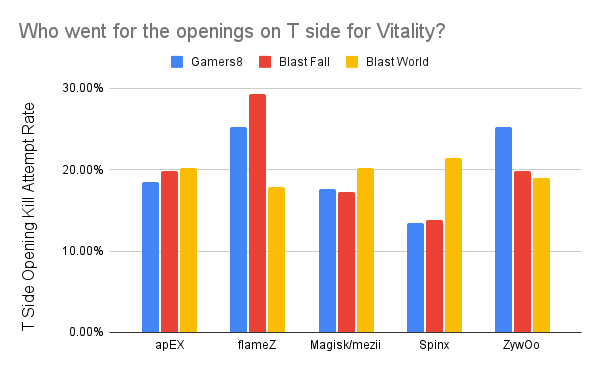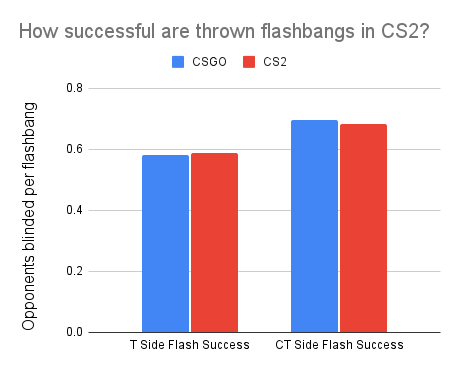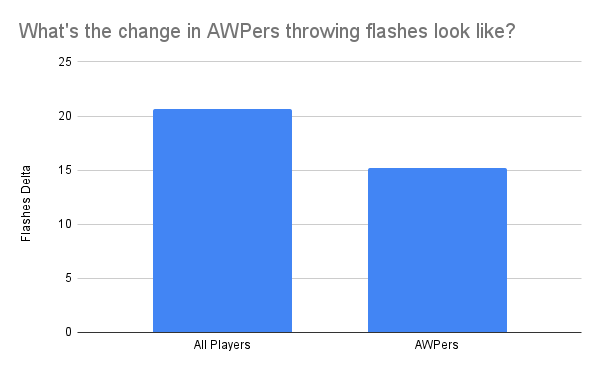CS2: The Death Of The Flashbang
I take a look at changes in flashbang statistics in CS2 and reveal some interesting truths, while also providing my conjecture on why things have changed.
Edit: If you’re coming here from a future YouTube video, I welcome you! If you want to check out a CS2 podcast I am working on, have a look at this, and enjoy!
Preamble
The story of this article starts in a largely unrelated place to the actual body of the text - it starts with Vitality, the most recent trophy lifters in CS2. With a lot of discussion regarding new players and style changes in the team, I was curious and began looking at statistics such as opening kills to determine who was doing what in the absence of players like Magisk, comparing the numbers on CT and T side across the different events they won.
To not waste the effort put into making the graph, I’ll include them here - I would have continued to make an article discussing further changes, talking about how flameZ is really turning up the CT side aggression while Spinx is taking initiative on T side more than usual.
However, when I clicked on the flashbang stats tab, I was struck with an oddity - the statistics from Gamers8, a CS:GO tournament, were noticeably more than the CS2 BLAST tournaments. This prompted a tangent of browsing statistics, and suffice to say, I felt it was more interesting than discussing Vitality.
Is the flashbang dead? Is CS2 the peeker’s advantage nightmare that doomsayers claim it is? (Not really.) This article will showcase the information I learnt, and provide some conjecture along the way to fill in the unknowns that will take time to iron out. If you have any thoughts or comments, be sure to send them my way on my Twitter.
Are Flashbangs Truly Dying?
Let’s start with the foundational truth - less flashbangs are being thrown per round in CS2. There are a variety of statistics related to flashbangs, so while I take you on this journey we can discuss the implications of each one.

There could be a few reasons for this, ranging from MR12 resulting in a tighter economy, the cumbersome adaptation to a new meta where flashbangs simply aren’t as effective, or a higher emphasis on dry peeks. If less flashbangs are thrown, does this mean that players are blind less often?
The short answer is obviously, since less flashes means less time blind overall. I’ll save you the time spent looking at three graphs that tell you the same story that the initial graph told you. Suffice to say that throwing less flashbangs means that the average player spends less seconds blind per round, and they flash opponents for less seconds per round. That’s nothing new given the above info.
Let’s start by ruling out the options we can analyse - first of all, whether or not flashbangs are as effective as they were in GO.
There are multiple ways to measure the success of a flashbang, and we will go over as many as I can measure (from the data HLTV gathers). The above graph actually shows that despite the drop in flashbang usage, the flashbangs are still as effective per flashbang thrown.
This tells us something that should be obvious given the flashbang didn’t get “nerfed” directly. A thrown flashbang should blind an opponent all the same. But it actually rules out the flashbangs themselves as being a part of the reason why they aren’t used as much in CS2, and allows us to narrow our focus elsewhere.
Here’s a familiar sight for those of you who read my AWPing article - the delta! It’s a percentage based measure, comparing the current state of a number to how it was before. In this case, I am measuring the percentage change from GO to 2.
This is meaty, so let me parse it in this way - the leftmost columns are the actual decrease in flashbang usage (22% fewer flashbangs used on T side, 18% fewer used on CT), and the columns afterwards are the decreases in time spent blind, time opponents were blinded, the “diff” (i.e. did you blind more than you were blinded?) and the flash assists per round.
Logically, everything should decrease proportionally in similar amounts to the decrease in flashbangs, if the change is viewed in isolation. But the proportional decrease in time spent blinded for Ts is not the same factor that decreases the opponents flashed for them - it’s the reverse effect for time spent blinded, since you are blinded by your opponent’s flashbangs. The fact that the CTs didn’t decrease their flashbang usage as much as the Ts did, means that the “diff” for the T side decreased much more.
This requires further explaining as to what the “diff” actually is!
That’s easier to digest, right? It also explains something that wasn’t fully mentioned earlier - the CT side has a negative diff, i.e. they are flashed more than they flash others. This makes sense if you think about it in a simplistic sense, where Ts flash to execute into a site and CTs are blinded while they hold angles; the T side would blind the CT side more often overall.
The “diff deltas” in the graph above actually mean the T side is nerfed (their positive diff is being decreased), while the CT side is buffed (their negative diff is not as negative).
Since the T sided economy should be more stable than the CT side (which I may have to do a separate article on…) there should be less problems with purchasing flashes.
The conclusion I believe is at the end of this long tunnel is that it’s a conscious choice from the T side to purchase less flashbangs and allow themselves to blind less opponents while still being blinded themselves, in order to feel more comfortable with the new game. But then it begs the question - is this better, or just a comfort choice?
Are we seeing more dry peeks?
First of all, what is a dry peek? Put statistically, it’s a kill that does not have a flash assist attached to it in the feed. It’s normally used to distinguish between flash assisted kills - I’m sure when you simply peek an opponent in your regular matchmaking games that are barren of utility usage, you don’t consider those peeks dry since they are so normal to you (and me).
The simple conclusion I’ve come to is this - if the KPR across the games is constant, but the flash assists are decreasing, there have to be more kills achieved without the aid of a flashbang.
The information above tells you that opening duels, contrary to perception, have not necessarily had a drastic shift. Especially on the T side, people have been up in arms about how easy it is to take peeks - but it seems the pros have the same success that they had before.
If you’re thinking what I’m thinking then, you’ll point at the slight dip in opening duel success for the CT sides in CS2 and ask questions. I think it’s not that the T side is much better necessarily, but just that the more fragile MR12 economy and the decreased AWP usage is resulting in a slightly more noticeable dip. Nothing too crazy.
Cleaning up the loose ends of the thought web
For clarity, I think it’s important to mention that utility ADR hasn’t significantly changed. I would attribute the slight change, if anything at all, to the HEs that are allocated to breaking smokes, notably on positions like Outside Nuke.
Edit (31/12/23) to mention: There is a possibility of HEs being more valuable and thus less flashbangs are purchased as a result. I considered this but did not think sufficient data existed to make it a talking point - but given that people are mentioning it (shout out TeaTime) I thought it prudent to mention it for clarity.
Here’s the final loose end that I think is worth mentioning; the previously discussed reduction in AWPing frequency means that the AWP players, who were previously controlling the game from the back and throwing flashes most frequently (think of cadiaN, Jame, FalleN, broky, acoR, etc.) might have to move to the front more often.
The graphs above show that this is not really the case - while they use less flashbangs than before, the overall change is not as marked of a difference compared to the non-AWPers. This makes sense - since the AWP players are not going to be going in first often, the flashbang resources that do get used still go to them. (Plus, they can’t afford flashbangs as often in the CS2 economy…)
Conclusion
Summary
There are a lot of graphs and statistics, so I’ll try and distil the takeaways in dot point form.
Flashbang usage has decreased a noticeable amount, a little more on the T side than the CT side.
The proportion of dry peeks has increased slightly as a result.
The strength of flashbangs that are still used is unchanged.
Opening duel success has not significantly changed despite this shift in the meta.
Utility damage has not changed significantly either.
AWPers also flash less per round, but their passive role is more resistant to this change than the average player.
I believe that the overall shifts of these changes imply that the terrorists are making a conscious decision based on feeling more comfortable with dry peeks, while the counter-terrorists likely cannot afford to maintain flashbang usage in a tighter MR12 economy.
While it may seem mundane to discuss things that haven’t changed, it’s an important part of the process in determining why certain things have changed. If, for example, opening duel success had changed, or flashbang success had changed, I wouldn’t naturally assume that it’s a comfortable choice but actually an optimal choice based on either a worse flashbang or a better kind of peek. The fact that these alternatives have been ruled out changes the route of the thought train towards the aforementioned talking points.
What happens next?
This is pure conjecture, but I suspect that the flashbang usage should stabilise once people get comfortable with the game and rosters are more stable. There is no “disadvantage” to a flashbang - no “advantage” to a peek, at least beyond CS:GO’s existing parameters. Holding angles has not been literally nerfed in any way I can notice; WarOwl made a great video essentially coming to the conclusion that if anything, it’s a visual feedback thing instead of a real mechanical difference.
I expect once the real tacticians get more comfortable (cadiaN on Liquid?) that we will return and perhaps even surpass the flashbang usage and other tactical components of CS:GO. Until then, enjoy a rough dry peek era!
Postface
Thank you for reading to the end of my article! A belated happy holidays to you all, and an early happy new year as well. This article was more of a flow of ideas with general conclusions - I hope the clickbait title/thumbnail image was not too off-putting.
I’ve been a little quiet on Twitter nowadays, but will ramp it up going into a new CS season. This coming year is the final year before Valve’s level playing field removes partner teams and changes invites, and I’m excited to see how CS2 develops.
Speaking personally, I’m happy that I managed to upload an article every month since April of 2023, and hopefully I’ll have something every month next year, if not more. I’m open to working in CS esports in some capacity as well if the opportunity is right - reach out to me on my Twitter for that, or just call me an idiot on there like the rest of the user base.














been reading back through your articles, keep putting out great stuff man :)